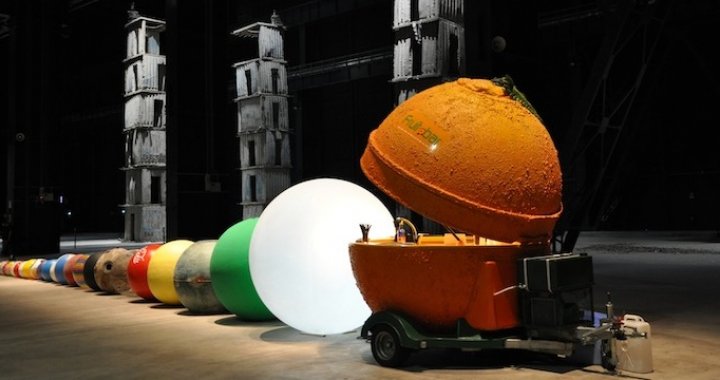
The Hangar and the Kabakovs
Una Meistere
16/08/2012
Although the transformation of old industrial zones into contemporary art spaces is a sanctioned practice these days, Hangar Bicocca, lying on the outskirts of Milan, is truly an outstanding example of this niche reformulation. From the outset, it had a definite objective – the hangar was redesigned as a venue for the exhibition of large-scale contemporary art installations; a visit to the hangar was to be a unique experience in terms of environmental and artistic perception. Driving there from the center of Milan, at first it seems as if you've arrived at some forgotten, industrial nowhere-land. A presumably feral, sun-dried field gives way to defunct factory buildings made of red brick. In a way, the picture before you is an optical illusion – the grandiosity and vastness of the space within is virtually impossible to imagine.
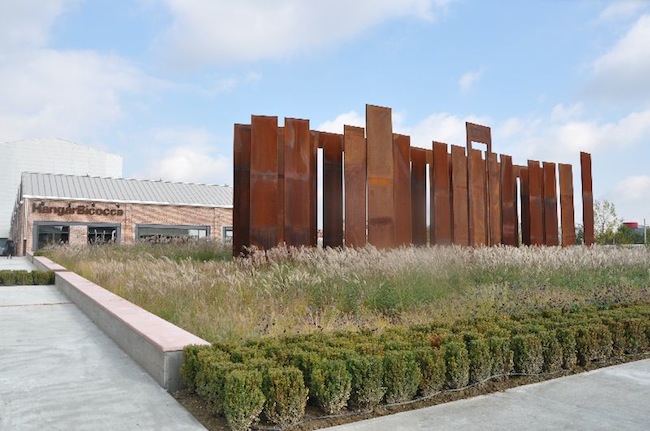
The historical background of Hangar Bicocca, which opened in 2010, goes all the way back to 1886, when the engineer Ernesto Breda moved his company to Milan's district of Bicocca. Later, similar moves were undertaken by Pirelli, Falck and Marelli, thereby forming the largest industrial center in Italy. Along with steam locomotives, airplanes were also manufactured here during WWI. A re-urbanization of the area started in the 1980's and as a result, the one-time factories also underwent changes. In 1986, the “Bicocca Project” – initiated by Pirelli, involved the construction of both a university building and private housing developments. The decision to create an art space came about in 2004. Marco Tronchetti Provera, the head of Pirelli, is the director of the Hangar Biccoca Fund; the other partners are the Region of Lombardy and the Milan Chamber of Commerce. As it says in their official statement, all three parties are convinced that “contemporary art has an important role in the identification and description of social transformation”.


The current Hangar Bicocco complex is composed of two connected factory buildings – Shed, built in the 1920's, and Cubo, erected in the 1950's. Both housed manufacturing facilities for the production of locomotive and agrarian machinery. The two buildings were combined into one monumental structure at the beginning of the 1960's, when the resulting whole served as a testing facility for modern electronic machinery. The space is grandiose – encompassing 9500 square feet, with an almost 30 foot-high ceiling. This is also the spot where the cornerstone of the hangar's permanent exhibit is located – the famous installation inspired by Kabbalah mysticism, “Seven Castles of Heaven” – composed of seven monumental concrete and lead towers by the German artist Anselm Kiefer. The towers symbolize the seven spiritual levels of the mystical road to heaven.
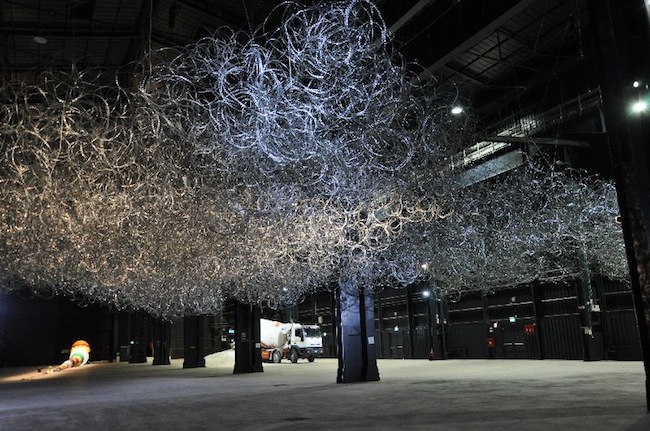
The space is entered by passing through huge, black “curtains”. At first, you literally feel as if you've entered a time warp. And then, like a little ant with its head arched back, you wander in amazement around Kiefer's unworldly towers of heaven. Nevertheless, you won't get any closer to them! There's no need to look far for more reminders of this unsettling truth. A symbol of the illusory greatness of humanity: a yellow bus struggling to keep itself balanced, a cement mixer and a gigantic “cloud” made of seven kilometers of wire – make up a nearby installation, created by the Cuban artist Wilfredo Pieto for the exhibition Equilibrando la curva. And then there's the “crowning glory” of global junk – an exhibit consisting of a vast array of round objects arranged by size: aquariums, globes, balls, mines, clock faces, radios... and at the very end – an orange juice bar. It's like playing with toy blocks, but the blocks are stages of economic development, filled with the symbols of financial success.
In this same space, the installation “The Happiest Man”, created by the well-known Russian artist pair Ilya and Emilia Kabakov, is on view through September 2. Specially made for the Jeu de Paume exhibition in Paris 2000, the piece has been put on exhibit as part of the project Artworks Against Time, the goal of which is to put on view the most notable installations of the past few decades in a new way, whereby they've been specially modified for the space in question.
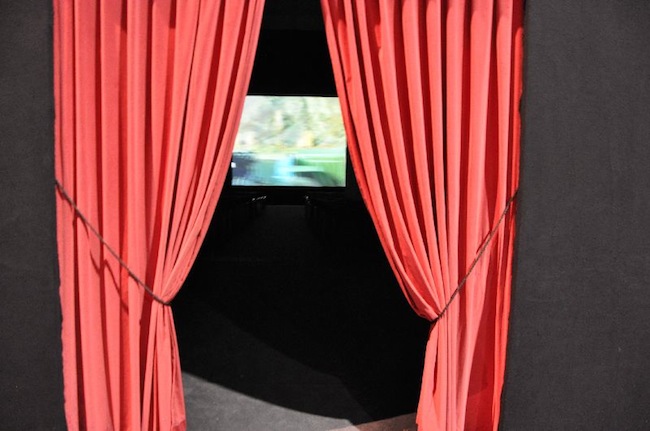
The work is situated in a corner of the art space, forcing the viewer to climb up a small platform onto a real stage. In the back end of the stage, behind heavy, red-velvet curtains, appears something like a small, improvised movie theater. Flickering on the screen is some classic, soviet-era film – girls with watermelons, then men in heavy military coats. Once your eyes get used to the dark, on the right side you notice a small and simple wooden caravan, which just as well could have served as housing for the factory's one-time workers.
Inside the caravan, you find the very modest, stylized living quarters of a Russian emigrant, most likely from the intelligentsia – everything is thought out to the last detail: a carefully made bed and next to it – a wooden chair with an open book on top. In the middle of the room is a round table with flowery porcelain dishes and a matching tablecloth – ready for guests at any moment. The feeling of loneliness exuded by the room attests to the fact that people visit here rarely, if at all. A heavy wool coat lies thrown over the back of a chair, and a single suitcase sits on top of the cupboard. The humble room has only one small window, behind which the scene is constantly changing – by way of the films that are being projected. It's illusory, but as insistent as the ticking of a clock as it creates a scenario for the life that goes on behind the window. It's a mirage of reality that can be viewed, and you can choose to either not take part, or take part – as a watcher. The piece is a spot-on and ironic version about escaping from reality (from yourself), independent of the method you may choose – whether it be moving to another part of the world, hoping that life will be different there, and therefore – better; or, diving into the movie screen – replacing reality with a plot dreamed up by somebody else. Because in large part, the same things go on there, too; just in a concentrated, self-contained way. The joy of life and the intensity of pain are dependent only on how much of this “mirage of life” you let inside yourself at the given moment. It's just as possible that someone else may be satisfied with popular coffee-table “escape” almanacs, filled with dream-islands and hotels. As a matter of fact, last year the publishing house Steidl came out with a wonderful book, Alec Soth. Lester B. Morrison. Broken Manual – a four year-long photo story about people who have chosen to run away from civilization: monks, hermits, survivalists and others. And it's not just a documentary about “life on the edge”, but something like a handbook, of sorts, for those who may be occasionally plagued by similar thoughts.
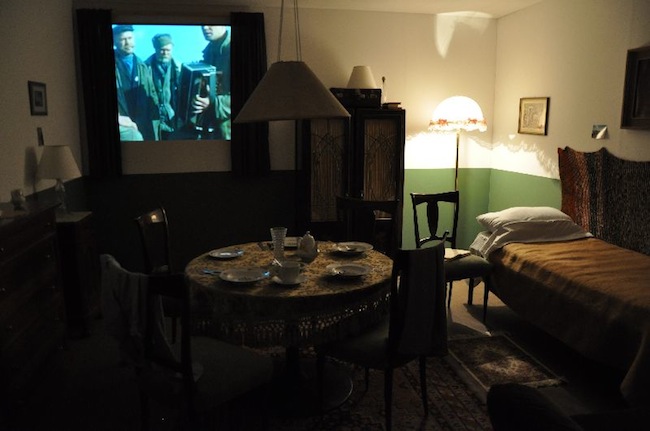
The most interesting thing is that when inside the Kabakov's little “caravan”, the window of illusion completely pulls you in and hypnotizes you; you just want to sit down right there – on one of the chairs set out for the unknown guests – and allow yourself to feel the glow that must come from “the happiest man”. Afterwards, you're left with a feeling of well-being – slightly sorrowful and, here and there, filled in with bits and pieces of private episodes taken from your own life. And the boundary between life and art, and illusion and reality, seems nothing more than a fragile spider's web.
On the lawn of the hangar one can view “La Sequenza” (1981), by the Italian artist Fausto Meloti; made of a series of vertical metal plates, it is one of the most important works by this Milanese artist. The installation is set up where the factory worker's caravans and shacks once stood. Right in the middle of the scenic wild field, it brings to mind thoughts of lavender fields, the surrounding air saturated with the scent of both verdant flora and machine oil. This masterfully directed interplay between space and form is one of the strongest features of Hangar Bicocca. The works aren't too numerous, which allows for each one to be experienced completely, and leaves the viewer room to explore the thoughts and feelings that they have evoked.